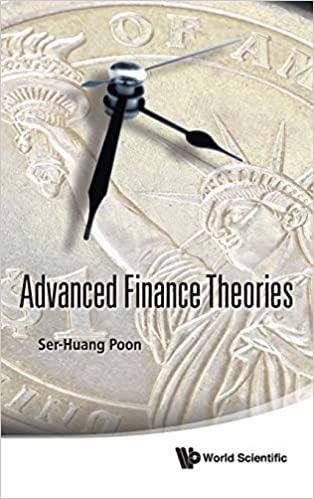Question
please answer question Use the following information to answer the questions. Security Beta Standard Deviation Expected return S&P 500 Risk-free security Stock D Stock E
please answer question
- Use the following information to answer the questions.
| Security | Beta | Standard Deviation | Expected return |
| S&P 500 Risk-free security Stock D Stock E Stock F | 1.0 0.0 ( ) 0.8 ( ) | 20% 0% 30% 15% 25% | 10.0% 4.0% 13.0% ( )% ( )% |
- Figure out the market risk premium using both S&P 500 and the risk-free security.
- Figure out a beta for Stock D and an expected return for Stock E using the CAPM equation.
- Stock F has a correlation with S&P 500 of 0.6 while the standard deviation of Stock F is 25% and the standard deviation of S&P is 20%. Figure out a beta for Stock F.
- If Stock F has an expected return of 12%, figure out the abnormal return, alpha (), based on CAPM and the beta you figure out in Question 3) (If you would like, you can use a beta of 1 instead.).
- You form a complete portfolio by investing $8,000 in S&P 500 and $2,000 in the risk-free security. Given the information about S&P 500 and the risk-free security on the table, figure out an expected return, a standard deviation, and a beta for the complete portfolio.
6) A complete portfolio of $1,000 is composed of the risk-free security and a risky portfolio, P, constructed with two risky securities, X and Y. The optimal weights of X and Y in P are 80% and 20% respectively. Given the risk-free rate of 4%. X has an expected return of 10%, and Y has an expected return of 12%.
a) Figure out an expected return for the risky portfolio, P.
b) To form a complete portfolio with an expected return of 7.2%, how much should you invest in risk-free security, securities X and Y, respectively?
| Variance-Covariance matrix | |||
|
| Stock H | Stock I | Stock J |
| Stock H | 0.0169 |
|
|
| Stock I | 0.0026 | 0.0400 |
|
| Stock J | 0.0156 | 0.0090 | 0.0225 |
- Use the following information to answer the questions.
You form two portfolios. You form Portfolio A by investing $2,000 in Stock H and $8,000 in Stock I while you form Portfolio B by investing $4,000 in Stock I and $6,000 in Stock J.
- Given expected returns of 0.06, 0.10, and 0.12 for Stocks H, I, and J respectively, Figure out the expected return for Portfolios A and B.
- Figure out the variance for Portfolios A and B.
- Given the risk free rate of 0.04, figure out the Sharpe ratio for Portfolios A and B. Which portfolio is better based on the Sharpe ratio?
Step by Step Solution
There are 3 Steps involved in it
Step: 1

Get Instant Access to Expert-Tailored Solutions
See step-by-step solutions with expert insights and AI powered tools for academic success
Step: 2

Step: 3

Ace Your Homework with AI
Get the answers you need in no time with our AI-driven, step-by-step assistance
Get Started


